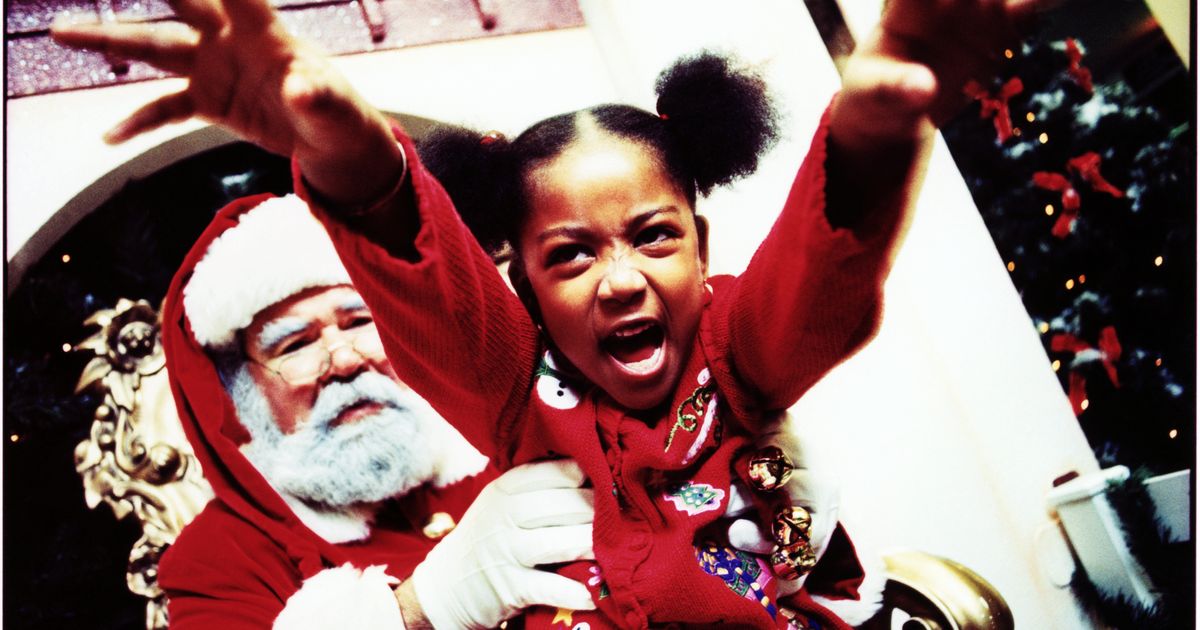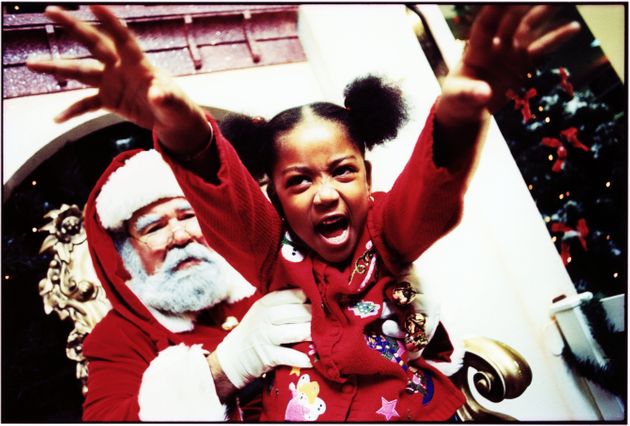
If you’ve taken your child to see Santa recently, chances are they’ll have reacted one of three ways: they’ll have been shy and a bit unsure, they’ll have been super excited and loved the experience, or they’ll have become really upset.
“If you’ve ever been to a Santa’s grotto it is very common to see kids responding fearfully when it’s their turn to see Santa,” says counsellor Chris Boobier. “The photos are not as parents expected, with many children in tears.”
Advertisement
Sometimes this fear of Saint Nick can spiral into something more. Year-on-year data reveals that Google searches for ‘Santaphobia’ have increased by 56% since last December, according to analysis by Crafted Beds, while searches for ‘fear of Santa’ have risen by 31%.
Why is Santa so scary?
If you think about it, it makes total sense that children would be wary of this strange man dressed in a bright red outfit with fake facial hair. Especially if they’ve been warned against interacting with strangers.
Then you’ve got all the additional storylines that surround Santa. The fact he watches over kids and knows if they’ve been naughty or nice, that he can squeeze down the chimney and drop presents into their bedrooms when they’re asleep.
“It completely goes against everything that is regularly taught about safety, causing conflicted feelings,” says Boobier.
Advertisement
On top of that, come December – heck, November – Santa is everywhere. “Now that you can write to Santa, get Santa to call you, go and see Santa, track him through the air, there is a lot ‘more’ of Santa than ever before and it can be overwhelming,” says the therapist.
“He changes size and shape, has different voices and it doesn’t quite add up: kids are smart and know something is afoot, but also believe what they are told.”
Then you’ve got the over-stimulating environment in which you usually find Santa – the bright lights, loud sounds and crowds of people at his grotto.
Combine that with a couple of years of not socialising much (thanks Covid) and it’s really no wonder more kids aren’t shaking in their boots on coming face-to-face with Mr Claus himself.
“We are in a post Covid world where children under four have not been socialised as much as before because of lockdowns,” says Counselling Directory member Claire Elmes. “This is feeding into many social difficulties, including visiting Santa.”
Advertisement
How to tell your child has a phobia of Santa
The point at which being scared of Santa turns into a full-blown phobia is usually after a negative experience has occurred and the child has linked this to Santa in some way. You might find, as a parent, that anything related to Santa or Christmas then triggers your child, causing a physical and emotional reaction.
You might even notice they start to react negatively to anyone wearing similar red coats, says hypnotherapist Penny Ling: “Our brain’s pattern match for danger. A person with a phobia of spiders will jump at a tomato stalk, so it stands to reason a child phobic about Santa will respond with fear around red coats and long white beards.”
Symptoms of Santaphobia could include your child feeling more anxious than usual, not wanting to go to bed on their own or having difficulty sleeping, says Boobier.
“They may want to avoid anything too ‘Christmassy’ like grottos or certain movies, and not talk about Santa. They may request stockings are not put in their room,” he adds.
Some children, on being faced with Santa, might become agitated and want to leave, adds Ling, who is a member of Hypnotherapy Directory. They might start crying or wet themselves if they are not taken out of the situation early enough.
Advertisement
If you’ve got this far, you’ve probably established that your child has a phobia of Santa – or at the very least, is uncomfortable by his presence. So what can you do about it?
Dos and don’ts for tackling Santaphobia
Do prepare your child for their trip to see Santa
Preparation is key ahead of a trip to see Father Christmas, says Claire Elmes. She recommends discussing what is likely to happen at the grotto and showing your child pictures of Santa ahead of it so they know and are prepared for what to expect.
“Explain that some children find him a bit scary and that’s ok, you will be with them and it is all safe,” she says. Sometimes it can be helpful to go with another child who is OK with Santa.
Don’t force them to sit on Santa’s lap
If you do get to the grotto and they become upset, don’t force them to sit on Saint Nick’s lap or have pictures taken, it’s not going to be enjoyable for the child or help their fear.
“Acknowledge their feelings,” suggests Elmes, “and accept they may not be ready. Gently encourage them to be a safe distance and observe others if possible.”
Advertisement
Boobier adds that parents might want to find other photo opportunities where their child can be themselves and be happy.
Don’t shame your child for being scared
Sometimes as parents it can be hard to put ourselves in our kids’ shoes and you might even tell your child to “stop being silly” because it’s “just Santa”. But Ling suggests this is unhelpful.
“Try to be encouraging, showing that other children are enjoying the experience and it’s just new for them,” she says.
Don’t make up stories about Santa to scare your child into behaving
Chris Boobier is also keen to convey that children begin to have awareness for make believe and reality between the ages of three and five, so anything up to the age of five could be completely real to them.
“The idea they are being watched and don’t want to be on the naughty list will feel very real,” he says. “Knowing to what depth our children believe this Christmas magic can help with pulling back on some on the ever-growing Christmas traditions we create (Elf on the Shelf, anyone?) and reduce the ongoing hype that Christmas has become.”
Advertisement
Elmes agrees: “As tempting as it is try not to use Santa as a bribe for being good (we’ve all been there!) telling children he is always watching can also be a bit scary.”
Do talk about their fears
Let your child tell you they are afraid of Santa and really listen to how they feel, allowing them time and space to explain why, suggest therapists.
“Whilst this can feel a bit sad for parents as they go to all the effort to make Christmas magical, listening and understanding how your child feels without dismissing their feelings is the key to helping your child cope at Christmas time,” Boobier adds.
“They may tell you what would feel better for them and some traditions could be altered as they grow up.”
Remember it probably won’t last forever
However you feel about your child’s response to Santa, Chris Boobier encourages parents to keep perspective: “Most children grow out of a fear for Santa past the age of five, depending on development progress, when they can confidently distinguish the difference between fantasy and reality – and they will become excited again about Santa Claus.”
Advertisement



